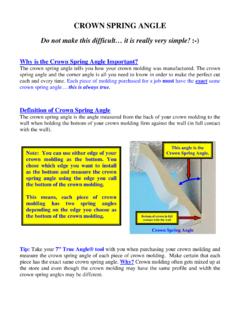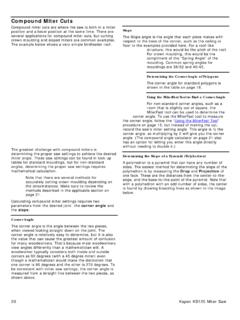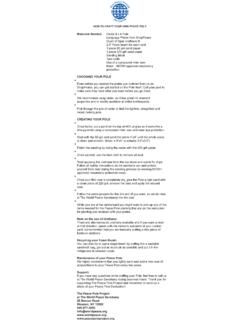Transcription of Creating Woodturnings that incorporate Slanted …
1 Creating Woodturnings that incorporate Slanted Staves This article is about Creating Woodturnings incorporating Slanted stave elements. Since this is an extension of the segmented vessel process let's start by comparing three methods of Creating segmented vessels used by turners to create pieces of art using multiple pieces of wood in combination. There other forms of the segmented art, but the three we'll discuss are: 1. Rings of staves 2. Rings of segments 3. Slanted stave rings Rings of Simple staves those with straight sides are a simple construction in which the key to success is to accurately make the two key elements angle and width of the stave close into a stave ring with no gap.
2 The angle is derived by a simple formula dividing 360 by the number of staves. Then for convenience to divide that by 2 to set your saw's bevel angle for two cuts. Hence, a stave construction of 8 staves would require dividing 360 by 8 to get 45 and then dividing that by 2 to get two equal cuts of . Once you know what you're accomplishing you can use the short form of this to divide 180 by the number of staves. The width of the stave can be roughly determined by dividing the circumference by the number of staves in the ring. For example: A ring of 8 staves with a circumference of 24 would seem to require 8.
3 Staves of 3 width. Actually due to the geometry of the ring and the flat cut staves, if you were to follow the above formula the finished circumference of your ring would be less than 24 in fact close to 22.. A more accurate calculation would be to use the formula: X = 2 x R x Tan Ca Where: X is the width of each stave; R is the radius of the ring; and Ca is the cut angle defined above. In this process you would have calculated the width of the stave to be about to get the ring you wanted. You could have made your staves by ripping a board at the proper angles, width, and length and cutting off equal sections along its length representing the height of your ring.
4 The grain in that case would be running parallel to the axis of the resulting ring. The other method would be to cut your staves from a four square board by cutting them across the grain; thus, the grain would run perpendicular to the ring's axis. In the first case the end grain would be exposed at the top and bottom of the ring and would need to be dealt with in attaching that ring to adjacent rings. In the second case, the end grain would be exposed at the sides of the staves and measures of attachment would need to be considered to account for the resulting weak glue joints.
5 The key to success here is to make sure that the bevel angle is actually (or what you've calculated based on the number of staves in your ring) and then to pay close attention to your technique. Rings of segments use the same math described above but with different names for the parameters. The key elements in a ring of segments are the segment length and cut angle. Cut angle is calculated the same by dividing 180 by the number of segments. Again 8 segments would have a cut angle of 180 divided by 8 or . What was the width of our stave is now called the length of our segment (SL) and is calculated: SL = 2 x R x Tan Ca All this is pretty straight forward because there is little difference in the math between the stave and the segment approach and the key to success is to make sure your bevel angle and segment length are cut precisely so that the ring closes on itself leaving no gaps.
6 Once again you need to pay close attention to your technique. Slanted Stave Rings are the third method and have a lot of the same elements as the simple rings of staves namely that they are made up of a ring of staves cut at precise widths and angles. The difference is that , due to the fact that the sides of the staves aren't parallel to the center axis of the ring ( , meaning that the stave is tilted in or out from the center of the ring), the angles are more complex and indeed are called compound angles. While the math is a little complex to reflect the fact that the sides aren't parallel to the axis of the ring it's relatively easy to run the calculations with a pretty elementary calculator (one with trig functions) once the formulae are available.
7 There are also published charts with the angles given once you know the basic elements which you'll get from your design drawing. The primary element is the slope of the side of the stave referenced to the base. If you picture a vessel sitting on a table, the base will be on the table and the slope you're after is the one that the side of the vessel makes with the table top. In the case of a vanilla stave bowl that angle would be 90 ( , straight up and down). As you tilt the side of your stave inward or outward the angle becomes less; for example: 75 , 60 , etc. This is the only real measurement necessary because your number of staves is that which you've planned for in your design.
8 The angle can be read using a protractor right off of your sketch. The first difficult part comes once you know the angles you have to set them precisely in both the blade angle (bevel) and miter angle (setting the miter gauge at some angle other than the 90 you would for a square cut). that 's two angles to deal with and they must be precise since one affects the other. Grasp the meaning of that statement. While you can tweak one of the angles a little if you find a gap in your fit, you can only do that to a pretty small degree because changing one angle affects the other.
9 What you hope to be doing with your tweak is taking out error in the angle you're tweaking not compensating for an error in the other angle. If you have error is the miter setting and trying to tweak the bevel angle of the blade you could be making things worse. Of course, you might get lucky and hit on a viable combination that just modifies the tilt angle a little. Good luck with that . Without doubt the best way to approach this situation is to have a means of setting both angles precisely to start with, but such isn't going to be the case often. However, there are things you can do to help by having a means of setting one of the angles to a known good angle and sneaking up on the other.
10 I'll give you a scenario that I've used. This is just one way and there are probably a lot more. This is an example of the method I've used employing an Incra 5000 table saw jig with which I can dial in angles to one half degree. The first step using this technique is to make sure the table is square with the blade and then square the jig with the table. Once you can cut exact 90 angles with the jig you can then dial in the angle you wish to within 1/2 using the jig's protractor. But 1/2 accuracy isn't close enough for most compound angle cuts. The solution is to pick a tilt angle close to your desired one but one which comes as close to a 1/2 setting of the miter angle as possible.






